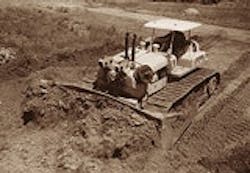General Motors' Crawler Tractor
Back in the early 1950s, management at General Motors Corp. (GM) decided to enter the earthmoving-equipment manufacturing business. After all, the company already had suitable engines for earthmoving equipment. Its Detroit Diesel engines were already offered by several other well-established manufacturers to power their earthmoving machines. Now all GM needed was its own range of equipment to expand application of its larger engines.
The Euclid TC-12 crawler tractor, designed and built by General Motors, was the world's most powerful crawler tractor when launched in 1955. It became a legend in earthmoving circles with its twin engines and fascinating frame design, split longitudinally to allow each half to oscillate over uneven ground.
It all started in 1952 when GM hired two engineers from a leading crawler-tractor company to head up its own crawler-tractor program. They immediately set to work on the big twin-engine model that would become the TC-12, and also a smaller tractor about half its size that would be known as the C-6. The following year, GM purchased Euclid Road Machinery, established the Euclid Division of General Motors, and put itself fairly and squarely in the earthmoving business. Euclid's line didn't include any crawler equipment, so its well-respected line of scrapers and haul trucks made a perfect "fit" with GM's own crawler tractors resulting in a full line of equipment ready to challenge any competition.
In 1955, GM officially launched the TC-12 to the market. This followed an intensive development program involving two "pilot" tractors that were thoroughly tested and modified, and another 10 prototype TC-12s tested by contractors across the country. The first production TC-12 tractors were rated at 402 net horsepower derived from two GM 6-71 diesels. Two three-speed Allison Torqmatic transmissions, one for each drive train, completed the twin-power configuration. Since each engine drove one track through its own power-shift transmission, the 40-ton tractor was remarkably nimble. Two transmission levers for steering and speed, and two foot pedals for brakes were all the driver needed to control machine movement. He steered the tractor by simply adjusting the speed or direction of one track. Spin turns were possible by putting one track in forward and the other in reverse with power supplied to both tracks at all times. With all of its size, the TC-12 was faster than most other crawler tractors, achieving 6.9 mph forward and 8.3 mph in reverse.
The TC-12 received upgrades and power increases to 413 net horsepower in 1956, and to 425 net horsepower in 1958. Some 500 units were sold from 1958 to 1966 when Euclid renumbered the model to the 82-80. In 1968, following a ruling by the American Justice Department, the earthmoving products of the Euclid Division of General Motors, excluding the haul trucks, were marketed under the new name of Terex. The 82-80 carried the Terex name until production finally ceased in 1974. By then, its power had reached 440 net horsepower and its weight 52 tons. But the twin-engined concept had run its course with new, larger and more efficient big single-engined dozers being offered.


